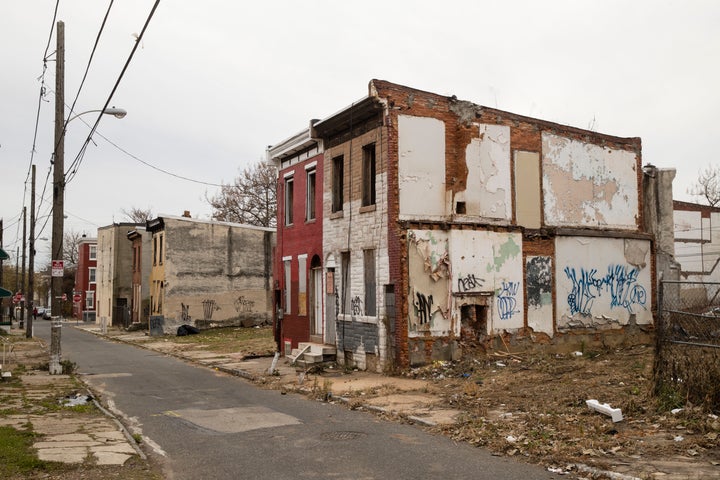
Fixing up overgrown, vacant and blighted lots in Philadelphia did more than beautify neglected areas of the city. Those improvements reduced firearm shootings ending in serious injury or death, according to new research.
“It’s not super costly. You can rely on locate local contractors and community groups to clean and green a lot. The cost of maintaining it is fairly low,” said John MacDonald, one of the authors of the new research and a professor of criminology and sociology at the University of Pennsylvania.
This cleaning-and-greening strategy may have the potential to save lives.
Gun violence isn’t equally distributed across cities. Instead it’s concentrated in neighborhoods or even city blocks. In aging deindustrialized cities like Philadelphia, those are often the same city blocks that have run-down and vacant lots.
In the new study, which was published in the American Journal of Public Health this week, researchers worked with the Pennsylvania Horticultural Society’s LandCare program to give randomized blighted lots either a full remediation treatment — meaning they cleaned the lot, put down grass seed, erected a picket fence and then maintained the property — or a partial treatment involving trash pickup and mowing only. Then they measured shootings before and after the remediation using Philadelphia Police Department data between 2011 to 2015. Untouched blighted lots served as a control group.
“Doing the full intervention, or doing at least a partial intervention of mowing and picking up trash, you see a significant reduction in shootings,” said MacDonald, noting that the full-treatment greened areas saw about a 7 percent reduction and the mowed areas saw about a 9 percent reduction.
The shootings didn’t just relocate around the corner or a few blocks away, either. “We didn’t see any evidence that crime was displaced,” MacDonald said. Instead, shootings in the surrounding area went down ― not significantly ― but enough to suggest that greening and cleaning might have some spillover benefits.
While mass shootings garner headlines, the reality is that more routine urban gun violence makes up the majority of the 14,000 firearm homicides and tens of thousands of nonfatal shootings that happen in the U.S. every year. In Philadelphia, which has a higher homicide rate than New York or Los Angeles, there were 6,000 shootings between 2011 and 2015.
‘Greening’ Is Spreading To Other Cities
The University of Pennsylvania’s latest study builds on years of research at the institution showing a link between remediating blighted urban spaces and reduced crime.
The relatively uncontroversial nature of cleaning vacant lots may make it an especially appealing option for cities with a combination of decaying vacant properties and gun violence.
Cities like Cincinnati, Houston and New Orleans have been inspired to start cleanup and maintenance programs of their own.
“In the world of gun violence prevention for cities, there aren’t a lot of options out there,” Charles Branas, one of the authors of the new study, told PBS News Hour in 2017. “This is an apolitical option. The gun lobby has no opposition to this stuff. It’s not in any way changing legal possession of firearms.”
Marc Zimmerman, a professor at the University of Michigan School of Public Health who has studied community greening in Flint, Michigan, said that while cleaning and greening might not be controversial in the gun control debate, it can spark a different controversy: fears about gentrification.
Still, he thought the benefits outweighed the costs, at least in the short term. “Living in places with violence has all kinds of negative health consequences,” he added.
MacDonald noted the limitations of the intervention. “You couldn’t green a city and just eliminate the chronic problems of gun violence that are highly concentrated in city blocks just by doing remediation to places,” he said, but added that there are other reasons, including potential health and safety benefits, for remediating vacant spaces that extend beyond gun violence.
“This is the kind of intervention that I’d like seen evaluated, but also done in cities across the country that have blight problems and vacant land problems,” he said.
A Different Kind Of ‘Broken Windows’ Philosophy
While the researchers can’t know for certain why the intervention worked, MacDonald explained that it’s consistent with “broken windows theory,” or the idea that there’s a connection between abandoned and unkept property and crime.
Fewer signs of decay can change the functionality of a space. If, instead of avoiding an overgrown and vacant space, people are using it and the areas around it for get-togethers and social gatherings, surveillance improves. There’s also a greater sense of social cohesion and more opportunity for the space to be used for socializing than for illegal activities.
Although the term “broken windows” is inextricably tied to the New York City Police Department’s aggressive policing policy ― where officers cracked down on petty crimes like vandalism and public urination in an effort to deter more serious offenses, and disproportionately targeted minorities in the process ― the theory had a life before the NYPD co-opted it.
“A piece of property is abandoned, weeds grow up, a window is smashed,” goes the famous “Broken Windows” article published in The Atlantic in 1982, co-written by a criminologist and a political scientist.
“What’s so striking is that the article was actually much more about broken windows than it was about bad people,” said Eric Klinenberg, a sociologist and author of the book Palaces for the People, which explores how investing in social infrastructure can help restore civic life and fight inequality.
But law enforcement often neglects that nuance. Instead of focusing on improving abandoned properties, cutting weeds and literally fixing the broken windows cited in the article, policymakers jumped right to fighting crime, Klinenberg explained.
“For decades now, we have fought crime by trying to crack down on people. By punishing people,” he said. “What we have not done is invest in places and rebuild places where crime is concentrated.”
CORRECTION: A previous version of this article referred to the Pennsylvania Horticultural Society as the Philadelphia Horticultural Society.
